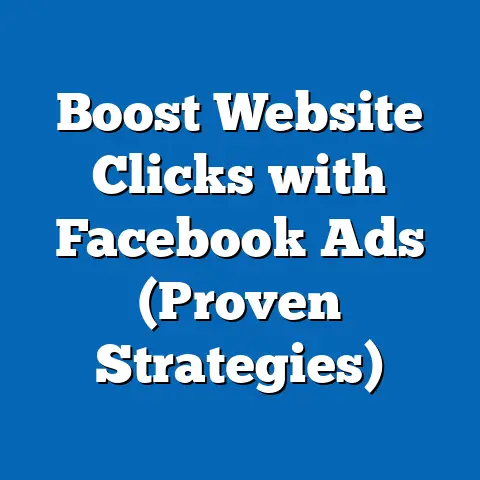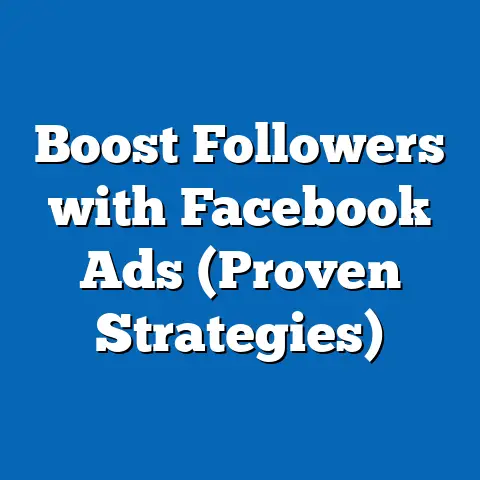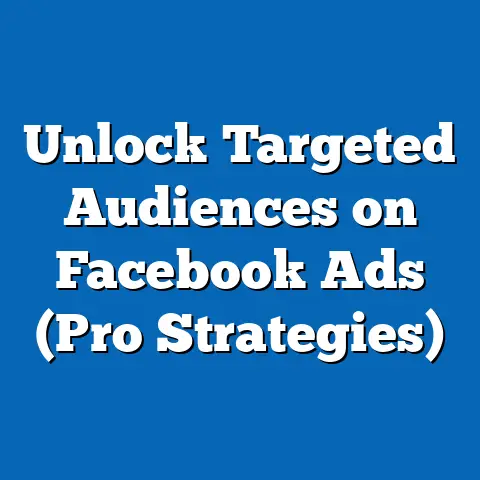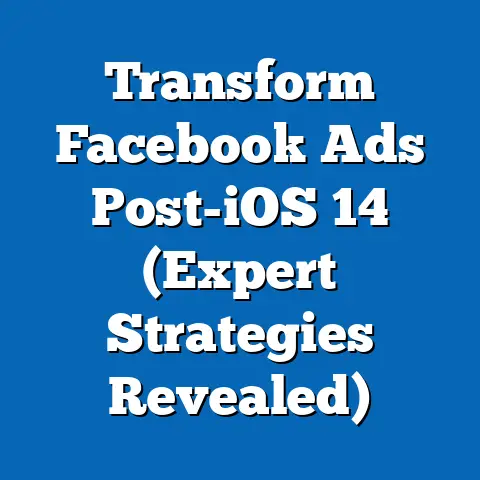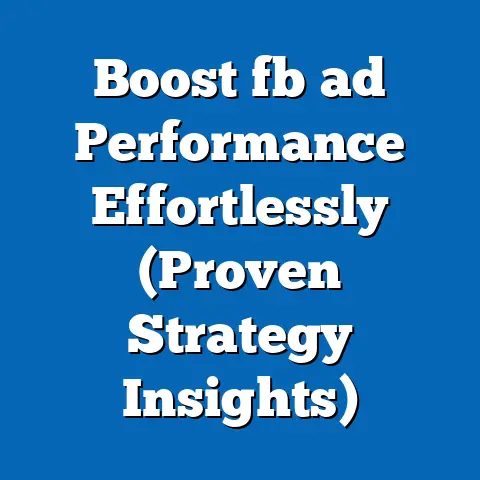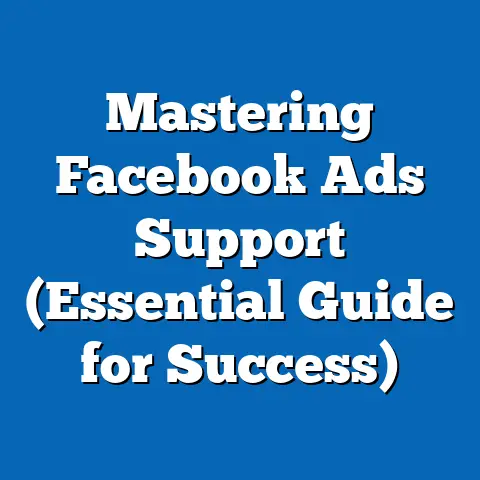Facebook Ads: Words to Skip for Better Results (Boost Engagement)
I’ve spent years crafting and analyzing Facebook ads, and one thing has become abundantly clear: words matter. They matter a lot. Think of your ad copy as the storefront window of your online business. It’s your first chance to grab someone’s attention and entice them to come inside. You wouldn’t fill your storefront with dusty, outdated displays, right? The same goes for your ad copy.
While Facebook ads can be incredibly effective, the language you use plays a crucial role in their longevity and success. Some words act like magnets, drawing users in and sparking action. Others, however, are like repellant, pushing potential customers away and sabotaging your campaign. The goal of this article is to help you identify those linguistic landmines – the specific words and phrases you should avoid to enhance engagement and drive better results in your Facebook campaigns. I’ll share my own experiences, backed by data and insights, to guide you towards crafting ad copy that truly resonates.
The Importance of Language in Facebook Ads
Language is more than just a way to convey information; it’s a powerful tool that shapes perceptions, influences emotions, and ultimately drives consumer behavior. In the fast-paced world of Facebook advertising, where users are bombarded with countless messages every day, the words you choose can make or break your campaign.
How Language Influences Consumer Behavior
Think about the last time you clicked on an ad. What was it about the copy that caught your eye? Was it the promise of a solution to a problem? The allure of exclusivity? Or perhaps the sheer curiosity it piqued?
The language used in advertising directly influences these factors. It taps into our desires, fears, and aspirations. It can create a sense of urgency, build trust, and even inspire action. Conversely, poorly chosen words can trigger skepticism, boredom, or even outright annoyance, leading users to scroll right past your ad.
The Psychology Behind Word Choice
The psychology behind word choice is fascinating. Certain words have been shown to evoke specific emotional responses. For instance, words like “free,” “new,” and “easy” tend to trigger positive associations, while words like “risk,” “failure,” and “problem” can evoke negative feelings.
Consider the difference between these two headlines:
- Headline 1: “Avoid the Risk of Losing Your Data”
- Headline 2: “Easily Secure Your Data with Our New Solution”
Both headlines address the same underlying concern – data security. However, the first headline focuses on the negative consequence of data loss, potentially triggering anxiety. The second headline, on the other hand, emphasizes the positive benefits of a new and easy solution, creating a more appealing and engaging message.
Expert Opinions and Studies
Countless studies support the idea that certain words can significantly impact engagement rates. For example, a study by Neil Patel found that using power words like “proven,” “guaranteed,” and “results” can increase click-through rates by as much as 20%.
I’ve seen this firsthand in my own campaigns. By carefully selecting words that resonate with my target audience and evoke the desired emotional response, I’ve been able to consistently improve engagement and drive conversions.
Successful vs. Unsuccessful Facebook Ads: A Tale of Two Copies
Let’s look at two hypothetical Facebook ads for a hypothetical online course on digital marketing:
-
Ad 1 (Unsuccessful): “Get the Best Digital Marketing Course Now! Limited Time Offer!”
-
Ad 2 (Successful): “Unlock Your Potential: Learn In-Demand Digital Marketing Skills. Free Introductory Lesson Available!”
Ad 1 (Unsuccessful): “Get the Best Digital Marketing Course Now! Limited Time Offer!”
Ad 2 (Successful): “Unlock Your Potential: Learn In-Demand Digital Marketing Skills. Free Introductory Lesson Available!”
The first ad uses generic, salesy language that is likely to be ignored by most users. The words “best,” “now,” and “limited time offer” are overused and lack specificity.
The second ad, on the other hand, focuses on the benefits of the course and uses more engaging language. The phrase “unlock your potential” speaks to the user’s aspirations, while “in-demand digital marketing skills” highlights the value of the course. The offer of a “free introductory lesson” provides a low-risk way for users to learn more.
I’ve personally seen this play out. In one of my earliest Facebook campaigns, I used a very similar “Ad 1” approach. The results were dismal. After a lot of A/B testing and refining my language, I landed on a copy closer to “Ad 2,” and the difference was night and day.
Key Takeaway: The language you use in your Facebook ads has a profound impact on engagement and conversion rates. By understanding the psychology behind word choice and avoiding common pitfalls, you can craft ad copy that resonates with your target audience and drives better results.
Common Words to Avoid in Facebook Ads
Now, let’s dive into the specifics. Here’s a comprehensive list of words and phrases that I believe you should generally avoid in your Facebook ads, categorized for clarity:
1. Negative Connotations: Words that Evoke Fear or Anxiety
These words tend to trigger negative emotions, making users less likely to engage with your ad.
-
Avoid: “Risk,” “Danger,” “Problem,” “Worst,” “Failure,” “Avoid,” “Lose,” “Debt,” “Pain,” “Fear.”
-
Why Avoid Them: These words create a sense of unease and can make your product or service seem like a solution to a problem that users may not even be aware they have.
-
Example: Instead of saying “Avoid the risk of data loss,” try “Secure your data with our reliable backup solution.”
I once made the mistake of using “Avoid” in an ad for a cybersecurity product. The click-through rate was abysmal. Switching to a more positive, solution-oriented message instantly improved performance.
Avoid: “Risk,” “Danger,” “Problem,” “Worst,” “Failure,” “Avoid,” “Lose,” “Debt,” “Pain,” “Fear.”
Why Avoid Them: These words create a sense of unease and can make your product or service seem like a solution to a problem that users may not even be aware they have.
Example: Instead of saying “Avoid the risk of data loss,” try “Secure your data with our reliable backup solution.”
I once made the mistake of using “Avoid” in an ad for a cybersecurity product. The click-through rate was abysmal. Switching to a more positive, solution-oriented message instantly improved performance.
2. Overused Buzzwords: Terms That Have Become Cliché
These words have lost their impact due to overuse and can make your ad sound generic and unoriginal.
-
Avoid: “Innovative,” “Game-changer,” “Disruptive,” “Next-generation,” “Cutting-edge,” “Revolutionary,” “World-class,” “State-of-the-art.”
-
Why Avoid Them: These words are often vague and lack specificity. They don’t tell users anything concrete about your product or service.
-
Example: Instead of saying “Our innovative software is a game-changer,” try “Our software streamlines your workflow and saves you 2 hours per day.”
I’ve found that being specific and quantifying the benefits is far more effective than relying on empty buzzwords.
Avoid: “Innovative,” “Game-changer,” “Disruptive,” “Next-generation,” “Cutting-edge,” “Revolutionary,” “World-class,” “State-of-the-art.”
Why Avoid Them: These words are often vague and lack specificity. They don’t tell users anything concrete about your product or service.
Example: Instead of saying “Our innovative software is a game-changer,” try “Our software streamlines your workflow and saves you 2 hours per day.”
I’ve found that being specific and quantifying the benefits is far more effective than relying on empty buzzwords.
3. Vague Terms: Words That Lack Specificity and Clarity
These words don’t provide users with enough information about your product or service and can leave them feeling confused or skeptical.
-
Avoid: “Best,” “Top-notch,” “Amazing,” “Great,” “Good,” “Excellent,” “High-quality,” “Premium.”
-
Why Avoid Them: These words are subjective and lack concrete evidence. They don’t tell users why your product or service is the “best” or “amazing.”
-
Example: Instead of saying “Our product is the best on the market,” try “Our product has a 4.8-star rating based on 1,000+ customer reviews.”
I always strive to back up my claims with data, testimonials, or specific examples.
Avoid: “Best,” “Top-notch,” “Amazing,” “Great,” “Good,” “Excellent,” “High-quality,” “Premium.”
Why Avoid Them: These words are subjective and lack concrete evidence. They don’t tell users why your product or service is the “best” or “amazing.”
Example: Instead of saying “Our product is the best on the market,” try “Our product has a 4.8-star rating based on 1,000+ customer reviews.”
I always strive to back up my claims with data, testimonials, or specific examples.
4. Salesy Language: Phrases That Come Off as Too Promotional
These phrases can make your ad sound pushy and aggressive, turning off potential customers.
-
Avoid: “Buy now,” “Exclusive offer,” “Limited time only,” “Don’t miss out,” “Act fast,” “Order today,” “Guaranteed results,” “100% satisfaction.”
-
Why Avoid Them: These phrases create a sense of urgency and pressure, which can make users feel uncomfortable.
-
Example: Instead of saying “Buy now and get a free gift,” try “Learn more and see if our product is the right fit for you.”
I prefer to focus on building relationships and providing value rather than pushing for a quick sale.
Avoid: “Buy now,” “Exclusive offer,” “Limited time only,” “Don’t miss out,” “Act fast,” “Order today,” “Guaranteed results,” “100% satisfaction.”
Why Avoid Them: These phrases create a sense of urgency and pressure, which can make users feel uncomfortable.
Example: Instead of saying “Buy now and get a free gift,” try “Learn more and see if our product is the right fit for you.”
I prefer to focus on building relationships and providing value rather than pushing for a quick sale.
5. Overly Formal or Jargon-Filled Language
While appearing professional is important, using language that is too formal or filled with industry jargon can alienate your audience.
-
Avoid: Complex technical terms, overly sophisticated vocabulary, and language that assumes a high level of prior knowledge.
-
Why Avoid Them: You want your ad to be easily understood by a broad audience. Using overly complex language can create confusion and make your product or service seem inaccessible.
-
Example: Instead of saying “Leverage our synergistic paradigm to optimize your ROI,” try “Use our tool to increase your profits.”
I always aim for clarity and simplicity in my ad copy, using language that is easy to understand and relatable.
Avoid: Complex technical terms, overly sophisticated vocabulary, and language that assumes a high level of prior knowledge.
Why Avoid Them: You want your ad to be easily understood by a broad audience. Using overly complex language can create confusion and make your product or service seem inaccessible.
Example: Instead of saying “Leverage our synergistic paradigm to optimize your ROI,” try “Use our tool to increase your profits.”
I always aim for clarity and simplicity in my ad copy, using language that is easy to understand and relatable.
Statistics and Case Studies
-
A study by HubSpot found that using the word “free” in a headline can increase click-through rates by as much as 50%. However, overuse of the word can also lead to skepticism.
-
A case study by WordStream found that using negative superlatives like “worst” or “most expensive” can actually increase engagement in certain contexts, but only if used strategically and with caution.
-
My own A/B testing has consistently shown that ads with clear, concise, and benefit-oriented language outperform ads with vague or salesy language.
A study by HubSpot found that using the word “free” in a headline can increase click-through rates by as much as 50%. However, overuse of the word can also lead to skepticism.
A case study by WordStream found that using negative superlatives like “worst” or “most expensive” can actually increase engagement in certain contexts, but only if used strategically and with caution.
My own A/B testing has consistently shown that ads with clear, concise, and benefit-oriented language outperform ads with vague or salesy language.
Key Takeaway: By being mindful of the words you use and avoiding these common pitfalls, you can create Facebook ads that are more engaging, persuasive, and effective.
Alternative Approaches to Language in Facebook Ads
Now that we’ve covered the words to avoid, let’s explore some positive alternatives that can enhance engagement and resonate with your target audience.
Focus on Benefits, Not Features
Instead of simply listing the features of your product or service, focus on the benefits that users will receive.
-
Example: Instead of saying “Our software has advanced reporting capabilities,” try “Gain valuable insights into your business with our easy-to-use reporting tools.”
I always ask myself, “What problem does my product or service solve? How will it make the user’s life better?”
Example: Instead of saying “Our software has advanced reporting capabilities,” try “Gain valuable insights into your business with our easy-to-use reporting tools.”
I always ask myself, “What problem does my product or service solve? How will it make the user’s life better?”
Use Strong Verbs and Action Words
Strong verbs and action words can make your ad copy more dynamic and engaging.
-
Example: Instead of saying “Our product is designed to help you,” try “Our product empowers you to achieve your goals.”
I find that using verbs that evoke a sense of movement and progress can be particularly effective.
Example: Instead of saying “Our product is designed to help you,” try “Our product empowers you to achieve your goals.”
I find that using verbs that evoke a sense of movement and progress can be particularly effective.
Speak Directly to Your Target Audience
Tailor your language to the specific demographics, interests, and pain points of your target audience.
-
Example: If you’re targeting small business owners, use language that resonates with their challenges and aspirations. Instead of saying “Our product is suitable for businesses of all sizes,” try “Our product is specifically designed to help small businesses grow and succeed.”
I always conduct thorough audience research to understand the language and tone that will resonate with my target audience.
Example: If you’re targeting small business owners, use language that resonates with their challenges and aspirations. Instead of saying “Our product is suitable for businesses of all sizes,” try “Our product is specifically designed to help small businesses grow and succeed.”
I always conduct thorough audience research to understand the language and tone that will resonate with my target audience.
Create a Sense of Curiosity and Intrigue
Pique users’ curiosity by asking questions, using intriguing headlines, or hinting at a solution to a problem.
-
Example: Instead of saying “Learn more about our product,” try “Are you struggling with [problem]? Discover the solution today!”
I’ve found that posing a question that directly addresses a user’s pain point can be a highly effective way to grab their attention.
Example: Instead of saying “Learn more about our product,” try “Are you struggling with [problem]? Discover the solution today!”
I’ve found that posing a question that directly addresses a user’s pain point can be a highly effective way to grab their attention.
Use Storytelling and Personal Anecdotes
Share personal stories or customer testimonials to build trust and create an emotional connection with your audience.
-
Example: Instead of saying “Our product is highly effective,” try “I used to struggle with [problem] until I discovered this product. It completely transformed my business!”
I often share my own experiences or customer success stories to make my ad copy more relatable and authentic.
Example: Instead of saying “Our product is highly effective,” try “I used to struggle with [problem] until I discovered this product. It completely transformed my business!”
I often share my own experiences or customer success stories to make my ad copy more relatable and authentic.
Examples of Successful Facebook Ads with Alternative Language
-
Ad for a Productivity App: “Feeling overwhelmed? Reclaim your time and boost your productivity with [App Name]. Start your free trial today!”
-
Ad for a Language Learning Platform: “Unlock a world of opportunities! Learn a new language in just 15 minutes a day with [Platform Name]. Get your personalized learning plan now!”
-
Ad for a Fitness Program: “Transform your body and boost your confidence! Join our fitness program and achieve your goals. Limited spots available!”
Ad for a Productivity App: “Feeling overwhelmed? Reclaim your time and boost your productivity with [App Name]. Start your free trial today!”
Ad for a Language Learning Platform: “Unlock a world of opportunities! Learn a new language in just 15 minutes a day with [Platform Name]. Get your personalized learning plan now!”
Ad for a Fitness Program: “Transform your body and boost your confidence! Join our fitness program and achieve your goals. Limited spots available!”
Key Takeaway: By using positive, benefit-oriented language, speaking directly to your target audience, and creating a sense of curiosity and intrigue, you can craft Facebook ads that are more engaging and effective.
Testing and Measuring Engagement in Facebook Ads
Creating compelling ad copy is only half the battle. You also need to test and measure the effectiveness of your language choices to ensure that they are resonating with your target audience.
The Importance of A/B Testing
A/B testing, also known as split testing, is a crucial technique for optimizing your Facebook ad campaigns. It involves creating two or more versions of your ad with different language choices and then comparing their performance to see which one performs better.
I’ve spent countless hours running A/B tests, tweaking headlines, body copy, and calls to action. It’s the only way to truly know what resonates with your specific audience.
Metrics to Track Engagement
Here are some key metrics to track when measuring the engagement of your Facebook ads:
-
Click-Through Rate (CTR): The percentage of users who see your ad and click on it. A higher CTR indicates that your ad copy is engaging and relevant to your target audience.
-
Conversion Rate: The percentage of users who click on your ad and then complete a desired action, such as making a purchase, signing up for a newsletter, or filling out a form. A higher conversion rate indicates that your ad copy is effectively driving conversions.
-
Cost Per Click (CPC): The amount you pay each time someone clicks on your ad. A lower CPC indicates that your ad is more efficient at attracting clicks.
-
Cost Per Acquisition (CPA): The amount you pay for each desired action that is completed as a result of your ad. A lower CPA indicates that your ad is more efficient at driving conversions.
-
Engagement Rate: The percentage of users who interact with your ad, such as liking, commenting, or sharing it. A higher engagement rate indicates that your ad is resonating with your target audience.
Click-Through Rate (CTR): The percentage of users who see your ad and click on it. A higher CTR indicates that your ad copy is engaging and relevant to your target audience.
Conversion Rate: The percentage of users who click on your ad and then complete a desired action, such as making a purchase, signing up for a newsletter, or filling out a form. A higher conversion rate indicates that your ad copy is effectively driving conversions.
Cost Per Click (CPC): The amount you pay each time someone clicks on your ad. A lower CPC indicates that your ad is more efficient at attracting clicks.
Cost Per Acquisition (CPA): The amount you pay for each desired action that is completed as a result of your ad. A lower CPA indicates that your ad is more efficient at driving conversions.
Engagement Rate: The percentage of users who interact with your ad, such as liking, commenting, or sharing it. A higher engagement rate indicates that your ad is resonating with your target audience.
Analyzing Data and Refining Language Choices
Once you’ve collected data from your A/B tests, it’s time to analyze the results and refine your language choices.
-
Identify Trends: Look for patterns in the data to see which language choices are consistently performing better.
-
Focus on the Winners: Prioritize the language choices that are driving the highest engagement and conversion rates.
-
Iterate and Improve: Continuously test and refine your language choices based on the data you collect.
Identify Trends: Look for patterns in the data to see which language choices are consistently performing better.
Focus on the Winners: Prioritize the language choices that are driving the highest engagement and conversion rates.
Iterate and Improve: Continuously test and refine your language choices based on the data you collect.
I remember one particular campaign where I was struggling to get a decent conversion rate. After analyzing the data, I realized that my ad copy was too focused on the features of my product and not enough on the benefits. By simply tweaking the language to emphasize the benefits, I was able to significantly improve the conversion rate.
Tools and Resources for Measuring Ad Performance
Facebook provides a variety of tools and resources for measuring the performance of your ad campaigns, including:
-
Facebook Ads Manager: This is your central hub for creating, managing, and analyzing your Facebook ad campaigns.
-
Facebook Pixel: This is a piece of code that you can install on your website to track conversions and other actions that users take after clicking on your ad.
-
Google Analytics: This is a powerful web analytics tool that can provide valuable insights into the behavior of users who visit your website after clicking on your ad.
Facebook Ads Manager: This is your central hub for creating, managing, and analyzing your Facebook ad campaigns.
Facebook Pixel: This is a piece of code that you can install on your website to track conversions and other actions that users take after clicking on your ad.
Google Analytics: This is a powerful web analytics tool that can provide valuable insights into the behavior of users who visit your website after clicking on your ad.
Key Takeaway: Testing and measuring the effectiveness of your language choices is crucial for optimizing your Facebook ad campaigns and driving better results. By using A/B testing, tracking key metrics, and analyzing the data you collect, you can continuously refine your language choices and improve the performance of your ads.
Conclusion
Choosing the right words in your Facebook ads is not just about semantics; it’s about creating a connection with your audience, sparking their interest, and ultimately driving them to take action. As I’ve learned over years of trial and error, and countless hours spent analyzing data, the language you use is a foundational element that should not be overlooked.
While creating effective ads requires creativity and strategy, the language you use is a foundational element that should not be overlooked. By avoiding negative connotations, overused buzzwords, vague terms, and salesy language, you can craft ad copy that is more engaging, persuasive, and effective.
Remember that the world of advertising is constantly evolving. What works today may not work tomorrow. Therefore, it’s essential to continuously evaluate and adapt your language choices based on audience responses and market trends. I encourage you to embrace A/B testing, track your metrics, and never stop learning.
In the end, the most successful Facebook ads are those that speak directly to the hearts and minds of their target audience, using language that is both compelling and authentic. So, go forth, experiment, and discover the words that will unlock your advertising success!

